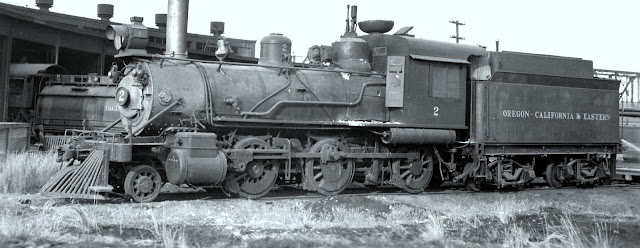The Oregon California & Eastern Railway
The Oregon, California & Eastern Railway ran between Klamath Falls and Bly, OR along a 64 mile right of way. Like most logging railroads, it also incorporated numerous spurs, some of which were quite lengthy themselves.
 |
| Oregon California & Eastern no. 2. Robert Graham Photo. |
The line began in 1919 by acquisition of the Klamath Falls Municipal Railway, running 20 miles to Dairy, reaching Bly in 1927. The initial goal of the route was to build it, connect to other major railways, and ideally sell it to a larger road, with the one in mind being the Southern Pacific Railroad, with whom it connected to at Klamath Falls.
In a twist of fate, the Southern Pacific purchased the OC&E in 1925 but operated it as a separate entity. Three years later, a unique partnership was forged when the Southern Pacific sold a half-interest in the OC&E to the Great Northern Railway. This arrangement led to an alternating operation of the railway between the two companies, each taking turns every five years.
Its primary haul was logging and timber, but was more than a simple logging road, despite major investment by the Weyerhaeuser Company later in its life. The longest logging spur from the OC&E emanated from Sycan, OR, where it ran 45 miles north to a spot known as 500 Transfer, serving numerous logging camps along the way. This was located near Yamsey Mountain.
 |
Oregon, California and Eastern Railway rolling stock; 50' Double Plug Door Hi-Cube Boxcar, 3399. Gary R Zuters photo. |
The OC&E’s legacy is a rich tapestry woven from the ambitions of early railway entrepreneurs, the strategic maneuvers of major rail companies, and the indelible mark of the Weyerhaeuser Company. It is a story of growth, change, and adaptation.
When a railroad line is "railbanked" in the United States, it means that no railroad activity is currently operating along the railbanked portion of the route, but that if a need for rail service along the line (in part or in whole) arises in the future, a railroad company can build along that right of way, which essentially keeps the line intact, while also allowing trail operations to exist between the time that the line enters railbanked status, and when it is reactivated, which in theory could last in perpetuity.
Thanks as always for reading!



Comments
Post a Comment